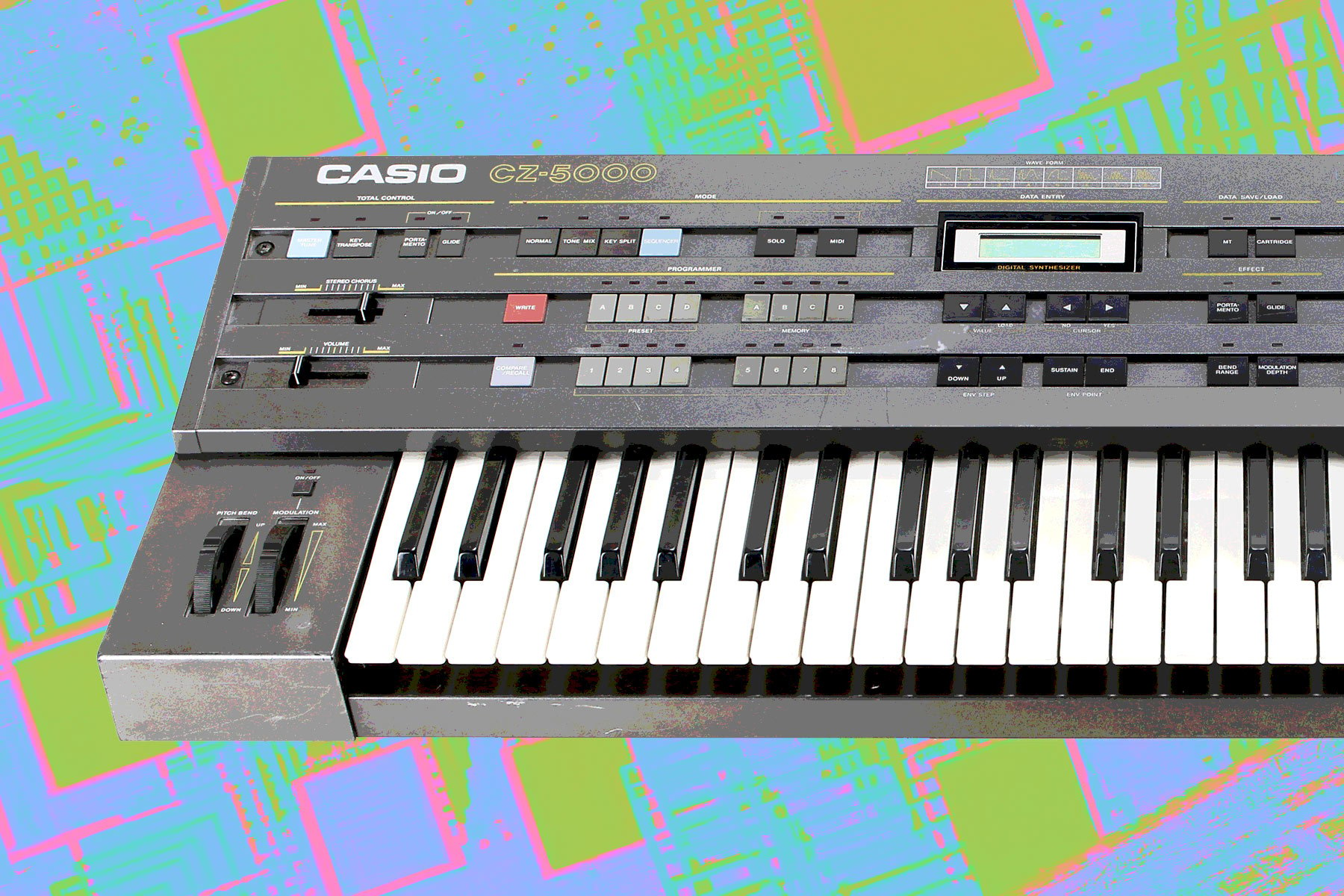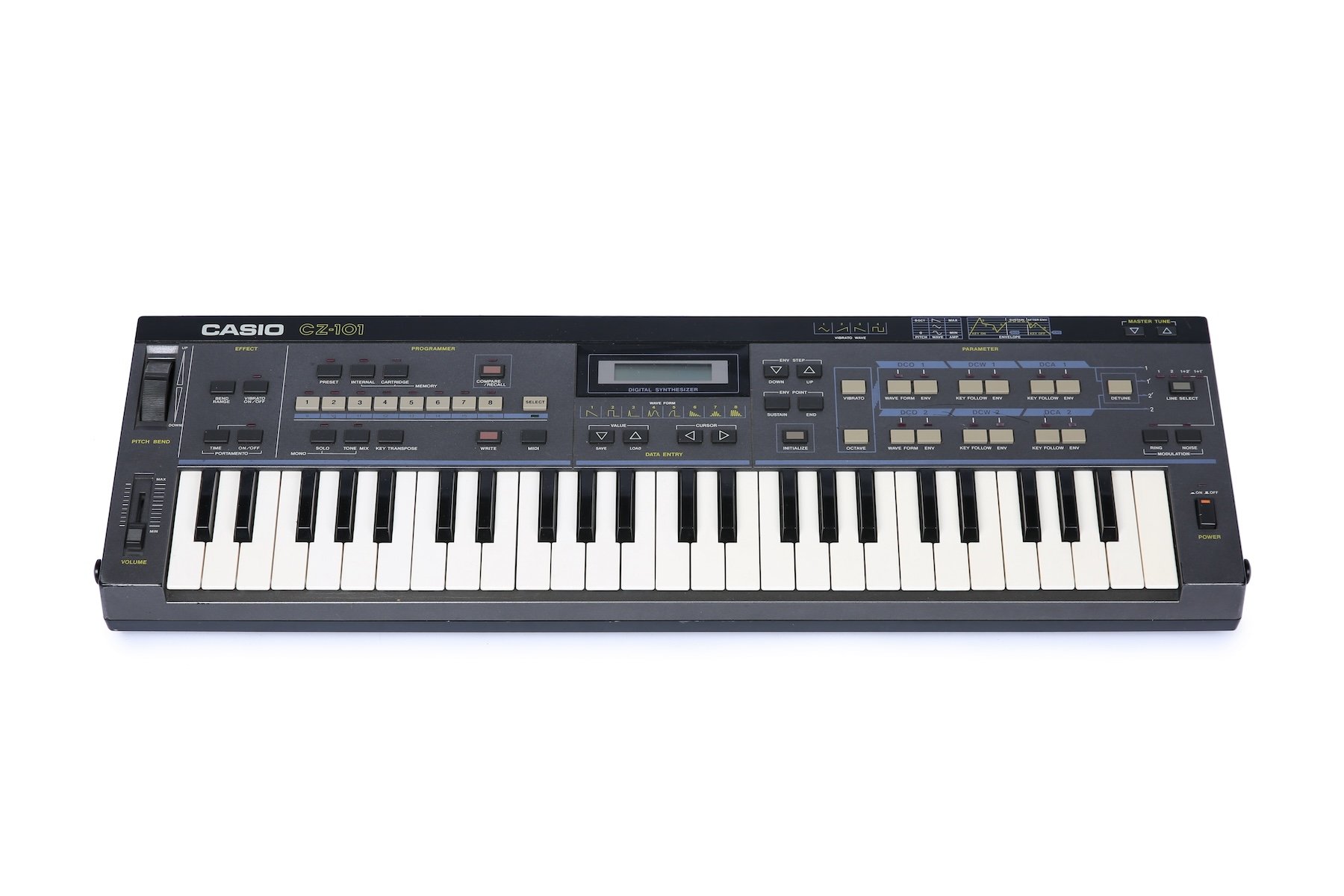Though commercial synthesizers began to emerge in the 1960s, the '80s is the decade most commonly associated with them—and for plenty of reasons.
In the early 1980s, the synth world was being revolutionized. From the establishment of MIDI to new digital designs waging war against antiquated analog synths, to consumers seeking affordable music making machines that weren’t expressly aimed at professionals—the 1980s were a turning point in electronic music production and synthesizer design altogether.
Here, we examine one of the pioneering and game-changing families of electronic instruments from this era: Casio’s unique CZ Series digital synthesizers. They pioneered a new type of synthesis and fought for the crown against their analog counterparts while taking on industry titans—and changing the concept of digital synths in the process—as the landscape around them shifted significantly.
Phase Distortion Synthesis in a World of FM
Let’s start by going over the design that set CZ synthesizers apart, the use of phase distortion synthesis. But what is phase distortion, and why does it exist?
In the 1980s Casio had an ongoing market share competition with Yamaha. Holding exclusive rights to the patent on frequency modulation synthesis (FM), Yamaha revolutionized a synthesizer industry already evolving at a record pace. FM synthesis was the backbone for their popular DX line, some of the best-selling electronic instruments of all time.
So, what made FM so popular? It's a complex topic. At the root of our answer is the fact that FM synthesis is capable of generating complex, realistic sounds with then unheard of levels of expression with relatively few sonic variables. This meant that the DX series was capable of a producing a wide range of sounds. But what's more, they included a large library of pre-set sounds designed to meet the demands of contemporary musicians: so, even without learning to program a DX synth, you could still take advantage of FM's versatility. Because Yamaha owned the legal rights to the technology, other manufacturers had to innovate their own synthesis methods for their proprietary synthesizers.
Casio developed their phase distortion synthesis methodology as a direct workaround to Yamaha’s FM patent. Instead of modulating a carrier waveform's total phase (as is typical of digital FM), Casio devised phase distortion synthesis to modulate waveshapes directly without uniformly altering the phase of the resulting waveform. This produced similar, desirable sounds without infringing on Yamaha’s intellectual property.
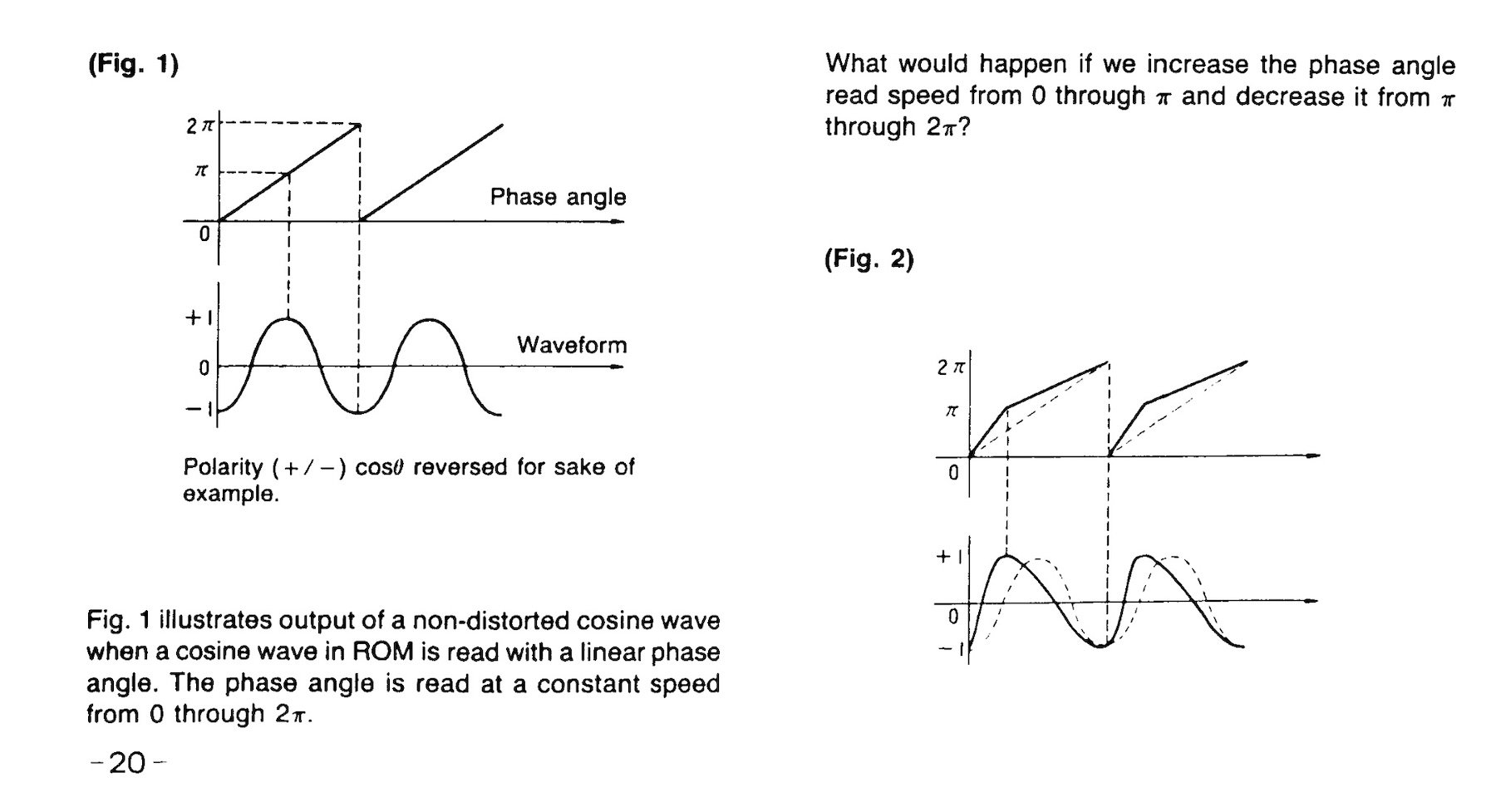
Phase distortion is a digital audio synthesis technique that creates sounds by skewing the phase of a waveform without altering its perceived frequency—essentially causing the waveform to time-distort or "squeeze" its shape, and thereby altering its harmonic spectrum. A variety of methods are used to modulate this "phase squeezing" effect, such as envelope generators, oscillators, and amplifiers…which we’ll get to in a moment.
Phase distortion can create changes in timbre that are more difficult, and sometimes impossible, through other types of synthesis. By altering the dynamics of a waveform’s harmonics, different sounds can be produced—ranging from natural instrument-like tones like drums and guitars to completely novel, synthetic sounds. Unlike the more common analog subtractive synth design that includes a filter, digital synthesizers don't necessarily need filtering (as they take different approaches to shaping timbre). A common sentiment with this type of design is that it results in a slightly “thinner” sound than analog approaches, so Casio simulated the filter section, accommodating those who needed that particular set of sonic tricks in their personal arsenals.
Sounds were based on eight types of waveforms that include square, sawtooth, and pulse that most synths used. But CZ series synthesizers also offered more esoteric options like double sine wave and half-sine wave. Three additional waveforms with filter resonance simulation include triangle, resonant sawtooth, and trapezoidal. Synth purists still argue that these filter resonance simulations aren’t convincing enough to sound like authentic resonant filters—but the use of digital synthesis is one of the things that gave the CZ series its sonic charm and made them affordable.
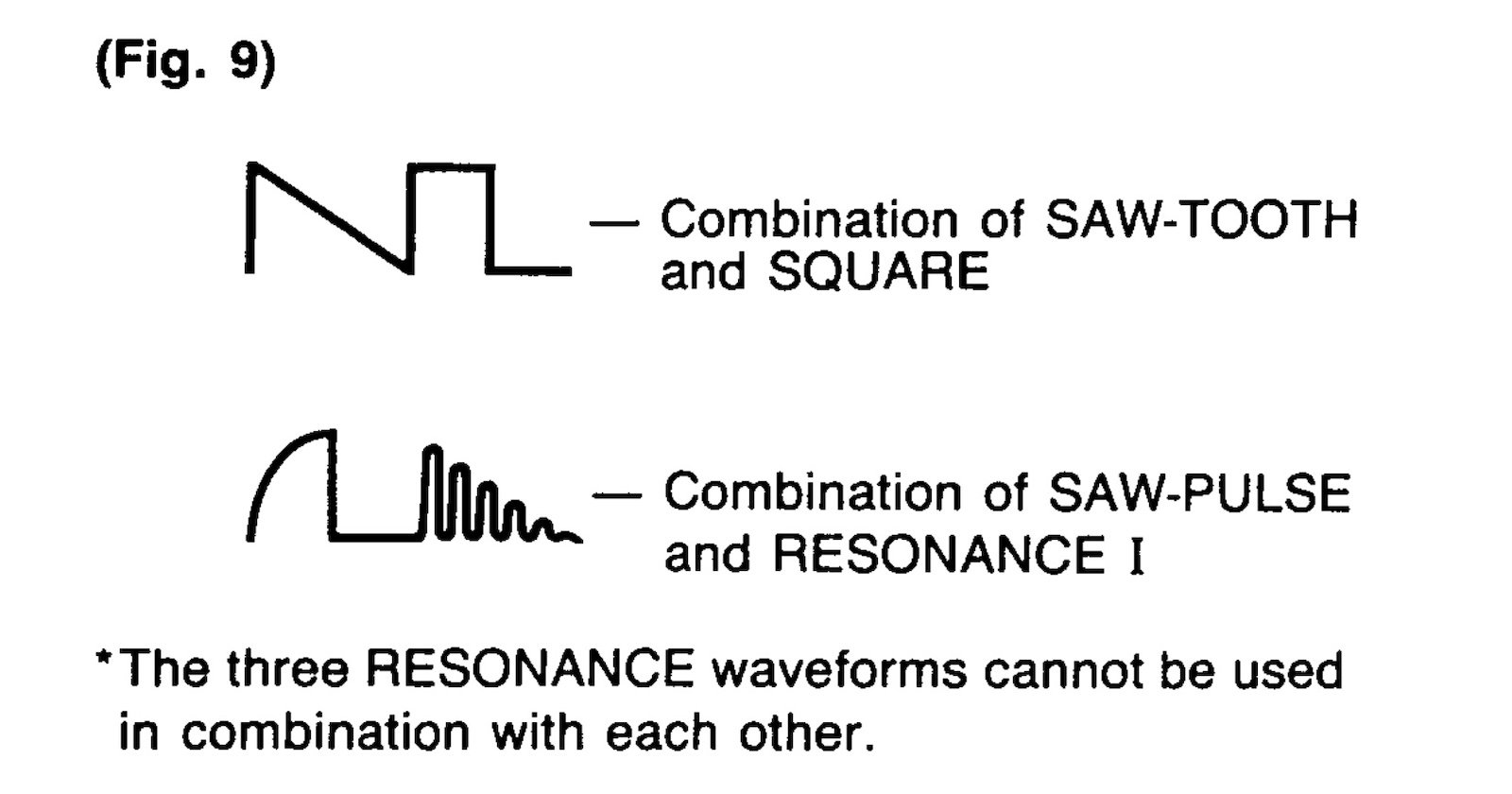
Most synthesizers mix multiple waveforms together in parallel, but the CZ series alternates multiple waveforms one after the other in series. This synthesizer design style wasn’t the norm, but it has its benefits for creating unique sounds. Because combined waveforms take double the time to form as a single waveform, octave-down subharmonics are created. The type of waveforms mixed together further affects the sound. The CZ could mix dual waveforms with no resonance, or resonant and non-resonant waveforms, but it didn’t allow for combination of two resonant waveforms.
Overall, phase distortion offers a lot of the advantages of alternatives like analog synthesis and FM without having to sacrifice much sound quality. With a unique, proprietary synthesis method at the ready, Casio recognized the revenue potential in the consumer and hobbyist market. In order to keep the CZ line of synths as affordable as possible for users outside of the professional world, digital synthesis and phase distortion in particular were a perfect choice.
Casio CZ Series Architecture
Other than the phase distortion synthesis principle, the CZ line of synths operated on three distinct types of digital sound control. Let’s go over what they are and how they work.
Digitally Controlled Oscillators (DCO)
Oscillators are the lifeblood of synthesizers. The CZ-101 and CZ-1000 both feature eight digital oscillators with an 8-stage pitch envelope for each. Note that these truly are digital oscillators, unlike the DCOs found in Roland's analog synthesizers of the era (which use digital control of an analog oscillator core to ensure pitch stability).
If only one oscillator is assigned to each voice, this means it’s polyphonic up to eight notes. Conversely, if two oscillators are dialed in on each voice, then the polyphony is reduced to four.
The CZ-101 and CZ-1000 have eight digital oscillators, each with a dedicated 8-stage pitch envelope. For patches using one oscillator per voice, this allows 8-note polyphony, Again, if two oscillators per voice are used, the polyphony is limited to four voices. The CZ-3000, CZ-5000, and CZ-1 had sixteen digital oscillators, though, making them sixteen- or eight-voice synthesizers. Each of the oscillators in a two-oscillator patch could be independently programmed.
Digital Controlled Wave (DCW)
This feature adjusts the manner in which phase distortion is applied to the oscillator. When used with non-resonant waves, it sets the harmonic content. A minimum setting produces a sine wave and at the maximum it produces whatever wave shape is selected. When applied to resonant wave shapes, it controls the apparent resonant frequency. Using the 8-stage envelope generator, it can change the timbre over time.
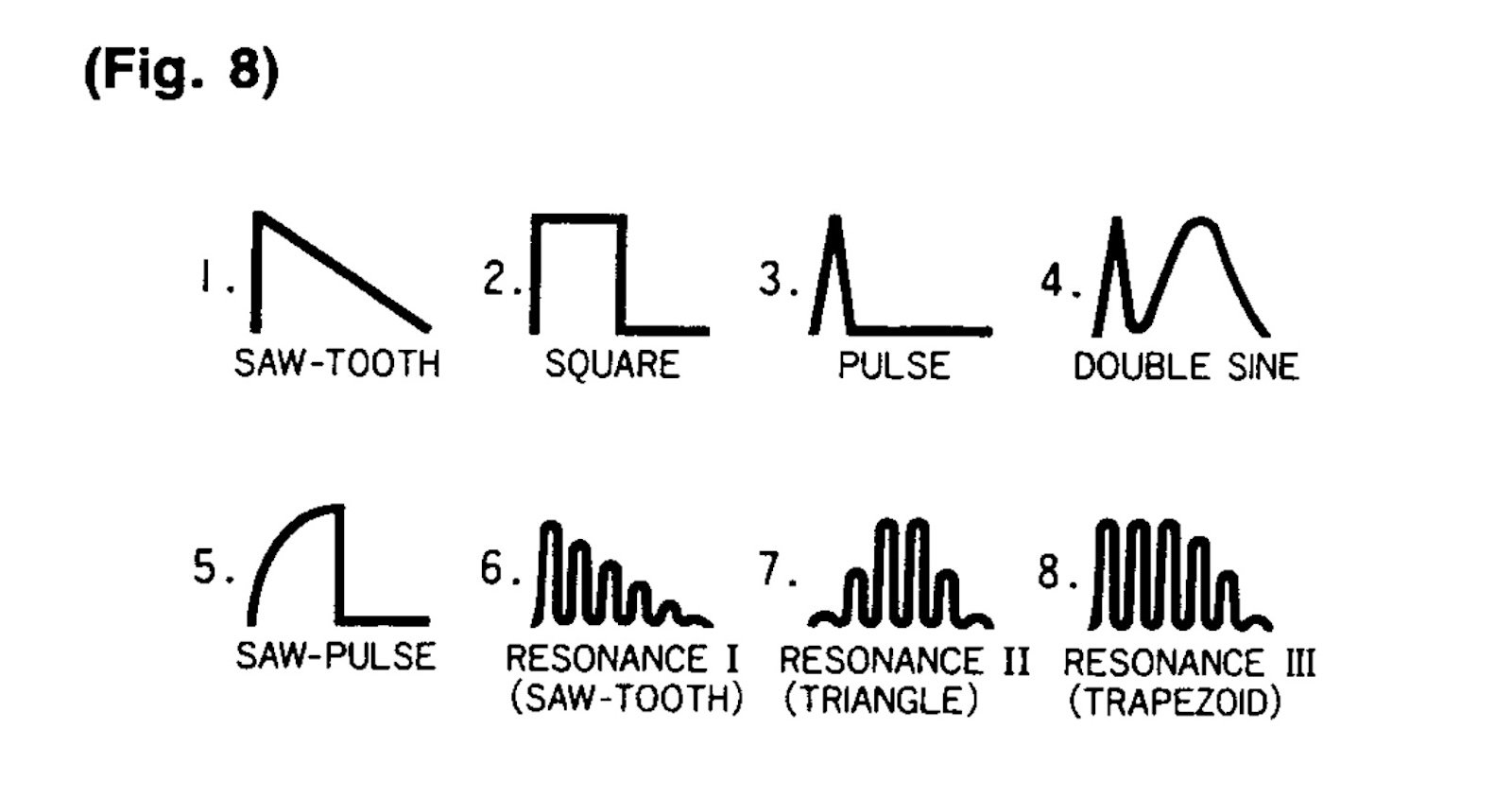
In essence, this serves the same function as a common analog synthesizer’s voltage-controlled filter: allowing for continuous changes to timbre over time.
Digital Controlled Amplifier (DCA)
The DCA parameter dials in the overall volume of the oscillation, and another 8-stage envelope generator modulates it.

Both the DCA and DCW had an additional level of control in the “key follow” feature. It determines the DCW value by reducing harmonic content on higher note registers and speeds up the envelope of the DCA on notes higher up on the keyboard.
History of the CZ Series
The CZ line included multiple models over the course of the mid- to late 1980s. They evolved into some of the best affordable digital synthesizers of the era, with appeal that started with consumers and hobbyists and eventually moved into the professional market.
CZ-101
There are a number of design elements that set the CZ series apart from other synthesizers. Released in late 1984, the CZ-101 was the first and best-selling model in the entire lineup. The biggest reason for this was that it was one of the first and best fully programmable polyphonic synthesizers of the time—available for under $500.
Casio reduced the total number of keys to 49, down from the standard 61 found on most synths. To make the unit more compact, they used miniature keys. And by enabling “Dual Synth Mode,” it allows for keyboard splits and layered sounds without having to menu dive.
Two digital oscillators produce multiple waveforms like sine, square, sawtooth, and pulse variations. Users control the pitch, phase distortion, and waveform of each oscillator. Four-stage envelope generators control the amplitude and pitch of sounds with precise control over the ADSR curve of the envelopes. Modulation is the name of the game with phase distortion, and the 101 doesn’t disappoint. Oscillator pitch and waveform, the filter’s cutoff frequency, and amplifier level can all be modulated through envelope generators and LFOs.
A headphone output also serves as a line out, but there is no internal speaker. It’s highly portable and runs on AC power…or six D batteries. It even had strap buttons like a guitar, so it could be played like a keytar too!
CZ-230S
Some features were added to the second model, most notably a built-in speaker. Preset sounds increased to 99, but they couldn’t be edited through the synth. A handful of sounds could be edited by connecting the unit to a computer via MIDI.
The CZ-230S includes the programmable drum machine from the Casio RZ-1 and has a sequencer with real-time and step modes. The most unique feature was the full MIDI connectivity, and was one of the first consumer keyboards to offer it.
CZ-1000
Essentially the CZ-101 with full-sized keys, with the CZ-1000, more focus was put on envelope shaping. It offers three sets of 8-stage envelope sections that provide a good amount of flexibility for changing up the sounds. They can be used to modify the pitch levels of the DCO, the phase angle of the DCW, and the volume of the DCA.
Four types of vibrato with controls over depth, rate, and delay were added, as well as noise and ring modulation. The overall number of sounds was reduced to 32, with 16 presets and 16 custom slots for users to save their own sounds.
CZ-2000S + CZ-2600S
The 61-key 2000S is where the CZ line truly began to evolve. Released in 1985, it features eight voices, dual oscillators with ring and noise modulation, and dedicated 8-stage volume, pitch, and phase envelopes for each voice along with the vibrato from the 1000 and an added chorus effect.
Presets expanded to 64, with 32 user-editable and it offered more ways to build sounds like a sequencer and arpeggiator. The built-in speakers returned, and it offered MIDI—but at the time, Casio did not sell this model in North America for some reason.
Another model never sold in North America, the CZ-2600S is identical to the 2000S except the built-in speakers are stereo. Both CZ-2000s models were used by popular European artists like The Cure, New Order, and Depeche Mode.
CZ-3000
Starting with the 3000, the CZ line started moving more and more into professional synth territory. The design is very similar to the CZ-101 and CZ-1000, adding many new features while keeping the familiar sounds and workflow.
The 61-key, five octave keyboard can be split, and it still has the 8-stage envelopes with two independently programmable oscillators per voice for a total of 16. Starting with the CZ-3000, the CZ series began resembling the popular Yamaha DX line more closely in sounds and aesthetic.
CZ-5000
This was far and away the most advanced CZ model yet. Casio’s third professional phase distortion synth boasts the feature set combined from the CZ-1, CZ-1000, and CZ-3000 units and keeps the familiar interface and programming methodology. Dual banks of DCOs provide 16-note polyphony, or eight if you double them—twice what the CZ-1000 offered. With the CZ-5000, Casio started encroaching on what the bulky (but powerful) contemporary PPG System was capable of.
It had the same 61-key, 5-octave keyboard with customizable location split function for bass and treble sounds. But there is a sustain issue where releasing keys held by one hand would kill those held by the other. This introduced some kinetic acrobatics that many claimed were a significant nuisance.
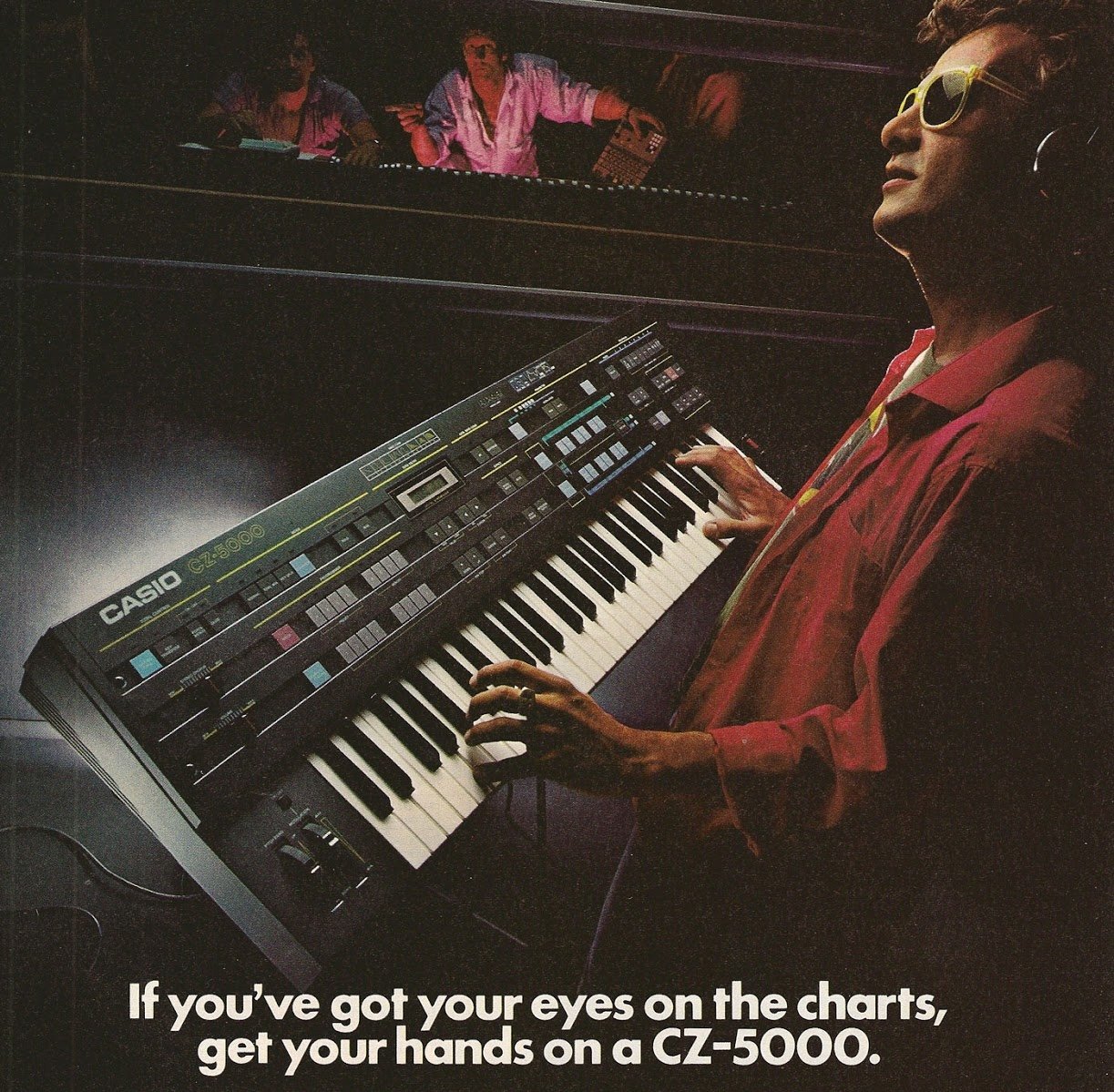
The onboard sequencer is the most advanced yet and offers eight tracks for creating patterns and storing ideas. Each track can be played back by itself or with any of the others and records in real or step time. Real-time editing of the 32 preset and user sounds made this a convenient workstation, albeit rudimentary considering today’s options. The expanded waveform memory provided the most sounds of any other model in the lineup.
Effects include noise and ring modulation and a stereo chorus that would be more useful if it provided a deeper level of control than a single Depth slider.
Along with the CZ-1, the 5000 is considered by many to be the peak of Casio digital synthesizers, and is often compared to the Yamaha DX7. It remained much more affordable than other alternatives on the market, and even today it’s regarded as a respected digital synth.
CZ-1
The CZ-1 stands with the CZ-5000 as the best and most full-featured model of Casio digital synthesizers. The 64-preset memory is arranged in eight banks with eight voices and 16 digital oscillators with each independently programmable. Cartridge expansion adds another 64. When it comes to sounds, the CZ-1 covered all of the necessary 1980s bases including pianos, acoustic guitar, sitar, strings, bass, and all kinds of percussion from marimbas to drum kits.
With the most editing parameters seen in the entire line, Casio enlarged the backlit LCD display to 32 characters. It’s located in the center for easy access, but didn’t offer any brightness or contrast controls so it could be difficult to see in certain environments.
It is the most advanced keyboard of the series, with the 61-key, five octave range of previous models but with added velocity and aftertouch sensitivity. Versatile I/O allows for easy integration with stereo line and headphone outputs, MIDI in/out/thru, and volume and sustain foot pedal inputs. The MIDI functionality of the CZ-1 is unique, specifically the mono multi-timbral mode. It allows for eight different monophonic sounds to be played simultaneously over different MIDI channels via external control. The volume of each was independently adjustable, but there are no individual voice outputs.
Onboard effects allow users to further tailor the sounds. There is a stereo chorus that can be switched on and off for each sound (it was the '80s after all…), though many users complained it added significant noise. For some reason, Casio did away with the onboard sequencer from the 5000, but by the time the CZ-1 was released in 1986, many users were integrating separate hardware units or even personal computers to that end.
There are a lot of comparisons between Casio’s CZ line and Yamaha’s FM models. But, with the CZ-1, Casio proved they weren’t just out to mimic their competition. They were creating something entirely new.
Revisiting: Casio CZ vs. Yamaha DX
A lot has been made over the years about the market title fight between the Casio CZ series and Yamaha’s DX line of synths.
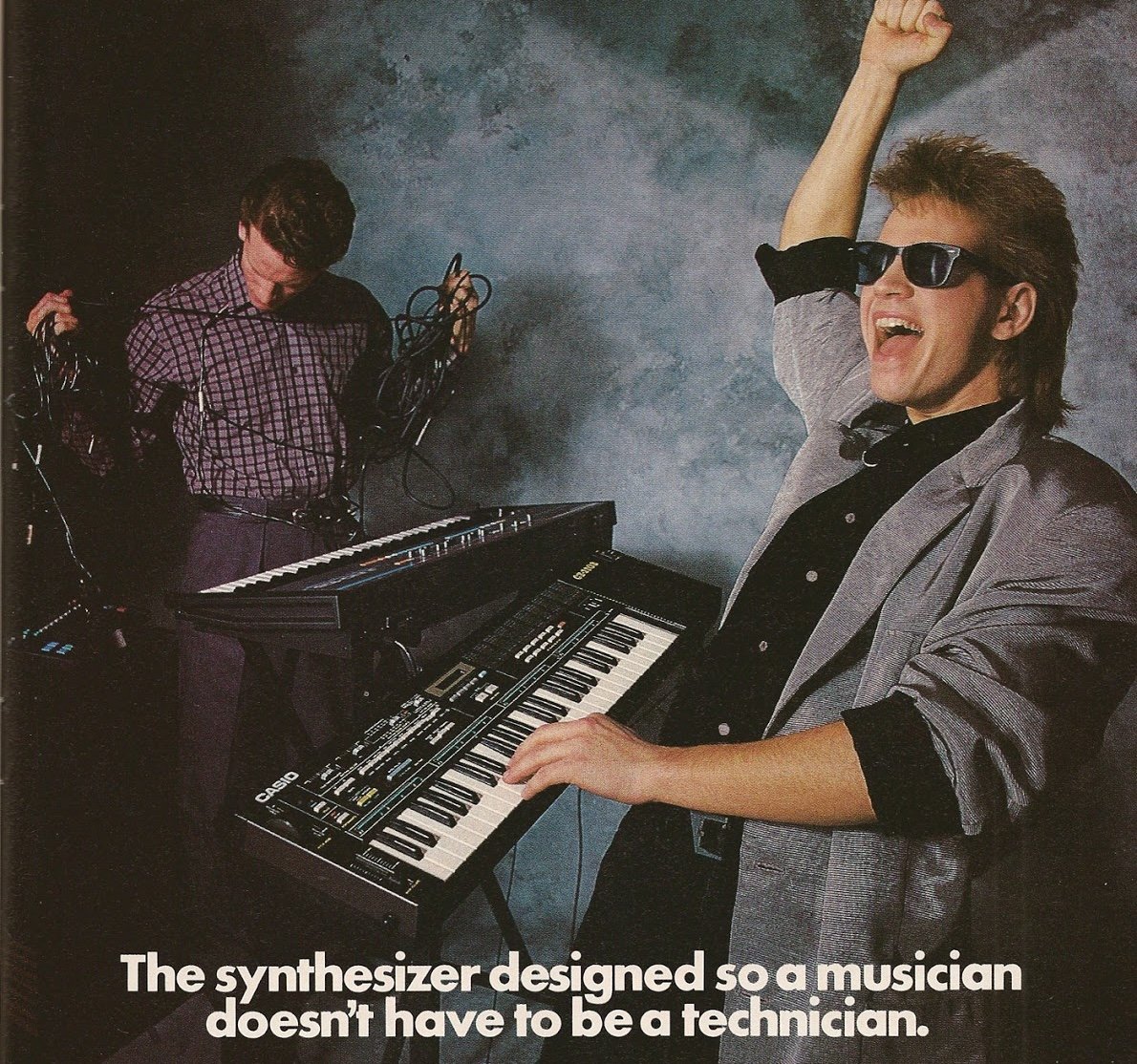 A period ad for the CZ-101, tailored to pitch its ease of use as a selling point.
A period ad for the CZ-101, tailored to pitch its ease of use as a selling point.
Phase distortion synthesis user a considerably smaller number of parameters than does Yamaha's implementation of FM synthesis—so it doesn’t require quite as much experience and manual pourover to use. That’s one of the reasons it took off with the consumer market. The way that Casio created control over waveforms is something that would take dedicated time to learn how to do with a Yamaha.
Phase distortion makes it easier to create familiar analog effects like falling pitches and filter sweeps, which can be difficult to create quickly on the Yamaha synths. The DX synths did have one control feature that was sorely missed in the CZ parameter set—a data entry slider. Instead of having to scroll incrementally through menus, this slider lets you go the entire settings range quickly.
Both the CZ and DX synth lines use very different and distinct ways of shaping sounds, and because of the rivalry between Casio and Yamaha it made them continue to innovate as they rolled out new products in their respective synthesizer lineups.
And as far as price point is concerned, the CZ line was much more cost effective compared to Yamaha’s DX line. But they were targeting different market segments. Casio was breaking ground with the home and amateur musician vertical while Yamaha was looking to appeal to professionals.
Taking Cues from Casio
Since the market clearly responded well to affordable digital synth models that didn’t sacrifice capability, Yamaha had to shift gears to stay competitive. They designed the DX-21 and DX-100 models as a direct answer to give users access to FM synthesis without the hefty price tag that came attached with models like the DX7.

[Above: the Yamaha DX-100, an FM synthesizer designed specifically for the consumer market.]
It wasn’t just the price that users were concerned about. The more user-friendly and intuitive interface design of the CZ lineup provided a more tactile approach than the seemingly endless menus of Yamahas. By moving into a new market segment, Yamaha intended to more heavily compete with companies like Casio and appeal to a broader range of synthesizer buyers.
Summary
The Casio CZ line was an important milestone in the development of digital synthesizers. During their release run from the mid to late 1980s, there were still so many questions around digital audio technology and what it was capable of.
Considering the ever-looming presence of Yamaha’s DX line and their legal rights to frequency modulation synthesis, it’s impressive that Casio not only came up with a legitimate alternative, they helped push digital audio technology forward in the process. From bedrooms to big budget studios, CZ synthesizers found a home with their unique control features and relative ease of use compared to similar options. The wallet-friendly price didn’t hurt the appeal either.
Their influence resounds in modern hardware instruments and software design. From pushing forward digital synthesis exploration and a streamlined interface design, to portability and affordability Casio CZ synths were trailblazers at a time when the musical instrument world was progressing at a rapid pace. Vintage synths have gone through a revival recently, and the demand for software emulations and virtual instruments that recreate their sounds has never been hotter.
The Casio CZ line is one among many reasons for that.
Brandon Stoner is a lifelong musician and audio engineer who owns more guitars than anyone needs. As a lover of all things writing and music technology, he crafts every piece with his dog Max on his lap.

